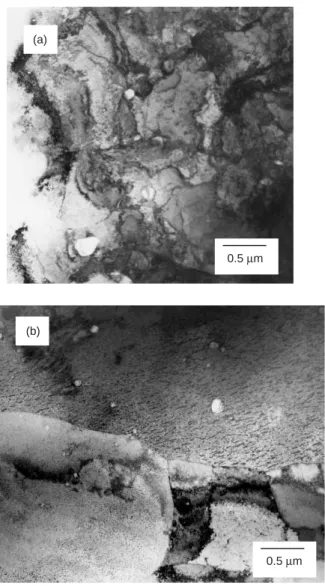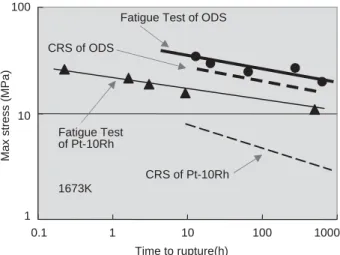1. 緒 言
近年溶融ガラスの搬送装置に白金系の材料が用い られる事例が多くなってきている。特に高い溶融温 度や不純物の少なさを要求されるような特殊なガラ スの製造装置には、炉材を用いた搬送装置よりも白 金材料で構成される搬送装置が用いられる傾向があ る。白金系の搬送装置の構成材料として、高温での 強度不足を補うために従来から固溶強化による白金 合金、例えば白金−ロジウム系等の合金が用いられ てきたが、さらに高温強度が必要な部位のためによ り高強度な材料が求められていた。そこで登場した のが酸化物分散強化(Oxide Dispersion Strengthened: ODS)白金合金であり、白金または白金ロジウム合 金のマトリックス中にジルコニウム酸化物の分散粒 子が存在する材料が一般的に使用されている。 しかしながら酸化物分散強化白金合金の強度特性 等のデータは充分に揃っているとは言い難く、搬送 装置の強度設計等の最適化も困難になっている。ク リープ特性に関する知見は多いが、より実用的な特 性の検討例が非常に少ない。実際の搬送装置は必然 的に長期にわたって高温に曝されることになるの で、長期高温暴露時の材料の特性変化に関する知見 が必要である。また、一般的に搬送装置には、温度 変化や温度ゆらぎが起きたり、スターラによる振動 があったりすることや、通電加熱の場合は通電によ る誘導振動のために反復的に応力を受けることが不 可避であるので、材料の高温での疲労特性に関する 知見が必要となってくる。 このような観点から酸化物分散強化白金合金につ いて、高温かつ長期間の挙動について検討を進めて いる。本報ではその結果について報告する。2. 実 験 方 法
供試材として田中貴金属工業(株)(TKK)、OMGAG. KG, Germany(OMG)、及びHeraus AG. KG, Germany(Heraus)製造による3種の酸化物分散強 化白金合金を準備した。また、比較材としてTKKの 製造による白金−10%ロジウム合金(Pt-Rh10合金) を用いた。酸化物分散強化白金合金については焼結 製法のものと溶融製法のものがあり、Table 1に準備 UDC:666.1.031.7:549.27
3. ガラス製造装置用の白金合金の高温特性
High Temperature Properties of Platinum Alloys for
Glass Manufacturing Process
富 田 成 明 *・浜 島 和 雄 *・大 林 浩 治 *
Naruaki Tomita, Kazuo Hamashima and Koji Obayashi
Oxide dispersion strengthened (ODS) platinum alloys have been developed for glass
feeder systems. For clarifying some mechanical properties to design the platinum glass
feeder, we studied high temperature properties of the ODS platinum alloys in
comparison with conventional platinum alloys. The tensile strength of the ODS alloys
annealed for long time at high temperature was still about three times stronger than that
of conventional platinum alloys, though the tensile strength of the ODS alloys was
decreased by the annealing. The fatigue strength at high temperature depended on the
tensile strength at room temperature of the ODS alloys, but there were contrasting
difference in the fracture mode. The ODS alloys broke in brittle mode, while the
conventional platinum alloys broke in ductile mode. As mechanical properties of ODS
are superior to conventional alloys, it is suggested that the sintered ODS platinum alloys
are useful significantly as material for the glass feeder systems.
*
した合金種の製法などを示した。合金は全て厚さ 1mmの板状材料を使用した。 合金からワイヤー放電加工機(WEDM)で切り出 した試験片を、電気炉中で大気中、1773Kでそれぞ れ2h、20h、200h、1200h加熱した。加熱後の試験片 は室温と1623KでそれぞれTable 2に示した条件で引 張特性を測定した。 また同様にWEDMで切り出した試験片について、 1473Kと1673Kで高温疲労試験を行った。疲労試験 装置の概略図をFig. 1に、疲労試験の諸条件をTable 3に示した。 各試験後の試料片は必要なものについては切断、 研磨や薄肉化を行い、光学顕微鏡、走査電子顕微鏡 (SEM)、透過電子顕微鏡(TEM)による微細組織 の観察を行った。
3. 結 果
Figure 2に室温測定での引張強度(a)と引張破断 伸び(b)の1773Kでの高温暴露時間による変化を、 Fig. 3に1623K測定での引張強度(a)と引張破断伸 び(b)の1773Kでの高温暴露時間による変化を示す。 室温測定ではどの合金についても高温暴露時間が延 びるほど引張強度は低下した。引張破断伸びについ ては、比較的短い時間の高温暴露では溶融製法によ る試料が大きな伸びを示したが、暴露時間が長くな るにつれ焼結製法による試料B、Cの伸びが増加する 傾向にあり、溶融製法試料の伸び優位性は小さくTable 1 List of Studied Samples.
Matrix Dispersion Process Supplier A Pt-10Rh None Melt TKK
C Pt-10Rh ZrO2 Sinter OMG
D Pt-10Rh ZrO2 Melt Heraus
B Pt-10Rh ZrO2 Sinter TKK
Table 2 Parameters of Tensile Tests.
Temperarture Room Temperature, 1623K Atmosphere Air
Deformation Rate 3.5×10-5s-1
Tensile Elongation
Measurement Marked points on samples
Table 3 Parameters of Fatigue Tests.
Temperarture 1473K, 1673K Atmosphere Air
Control Load-control (tension/tension) Cycle 10Hz
Load Ratio 0.1 Wave Pattern sin T.C.
Specimen
Furnace Super alloy
Al2O3
Fig. 1 Schematic image of apparatus for fatigue tests.
Tensile rupture strength (MPa)
Elongation (%) Heating time at 1773K (h) Heating time at 1773K (h) 0.1 1 10 100 1000 10000 0.1 1 10 100 1000 10000 R.T. R.T. (a) 40 35 30 25 20 15 10 5 0 600 500 400 300 200 100 0 (b) A B C D A (Pt-10Rh) B (FKS) C (ZGS) D (DPH)
Fig. 2 (a) Tensile strengths and (b) fracture strains of heated samples measured at room temperature.
なった。 一方、1623Kでの試験では、焼結製法による試料B、 Cの高温引張強度は室温特性と同様に暴露時間増加 とともに低下傾向にあったものの、長時間の高温暴 露後もPt-Rh10合金Aの約3倍の強度を示した。高温 引張破断伸びは、特に焼結製法による試料B、Cでは 非常に小さく、さらに暴露時間増加とともに低下し た。Pt-Rh10合金Aでは暴露時間増加とともに高温引 張伸びは減少傾向にあったが、高温引張強度は殆ど 変化しなかった。溶融製法による酸化物分散強化合 金試料Dは暴露時間増加とともに高温引張伸びが増 加した。 Figure 4にPt-Rh10合金 Aと分散強化合金Cの 1773Kで1200h加熱した後の試料断面の光学顕微鏡像 を示す。観察面は研磨後の面である。Pt-Rh10合金 では結晶粒が大きく成長していたのに対し、酸化物 粒子分散強合金では比較的小さい結晶粒のままで あった。分散強化合金では、高温保持時の合金結晶 粒の粒成長がよく抑制されていることがわかる。ま た焼結製法による分散強化合金では結晶粒子内や粒 界に多くの気孔が発生していた。 Figure 5に焼結製法の分散強化合金試料CとPt-Rh10合金試料Aの1473Kと1673Kでの疲労試験結果 を示す。1473Kと1673Kのどちらの温度においても 分散強化合金試料CがPt-Rh10合金試料Aの約3倍の 疲労強度を示した。Figure 6に高温疲労試験後の試 験片の外観写真を、Fig. 7に試料の疲労破断部付近 を切り出し加工し、破断部の断面を観察したSEM像 を示す。Pt-Rh10合金試料Aでは延性的に破断したの に対し、分散強化合金試料Cでは脆性的に破断した ことがわかる。Pt-Rh10合金試料と焼結製法の分散 強化合金試料では、破断モードは大きく異なった。
Tensile rupture strength (MPa)
Elongation (%) Heating time at 1773K (h) Heating time at 1773K (h) 0.1 1 10 100 1000 10000 0.1 1 10 100 1000 10000 1623 K 1623 K (a) 90 80 70 60 50 40 30 20 10 0 90 80 70 60 50 40 30 20 10 0 (b) A B C D A (Pt-10Rh) B (FKS) C (ZGS) D (DPH)
Fig. 3 (a) Tensile strengths and (b) fracture strains of heated samples measured at 1623K.
(a)
200 µm 200 µm
(b)
Fig. 4 Optical micrograph of polished surface of the (a) conventional alloy and (b) ODS alloy (sample C) after 1200h heating at 1673K.
Maxim u m stress (MP a ) Number of cycle : N 100 10 1 103 1673-A 1473-A 1673-C 1473-C 104 105 106 107 108 109
Fig. 5 Fatigue properties of sample A and C at 1473K and 1673k.
4. 考 察
4.1 分散粒子の挙動 分散強化合金の長期高温暴露時の強度を決めるひ とつの因子として、分散粒子の挙動がある。一般的 に分散粒子が凝集したり偏析したりすると強化機能 が低下することが知られている。高温暴露時の酸化 物分散粒子の状態を調べるため、高温暴露前後の酸 化 物 分 散 合 金 の 微 細 組 織 の T E M 観 察 を 行 っ た 。 Figure 8に分散強化合金Cについて、高温暴露前(a) と、ガラス製造装置で約2年間1673Kで高温暴露した 試料(b)のTEM観察像の代表例を示す。高温暴露 前試料においても高温暴露後試料においても、分散 粒子であるジルコニウム酸化物が分散して存在して いるのが観察でき、高温暴露中に酸化物分散粒子が 合金マトリックス中を容易には移動しえないことが 明らかである。すなわち、合金中の酸化物分散粒子 は、高温暴露しても殆ど偏析したり凝集しないと考 えられる。高温暴露後の酸化物粒子の分散性維持は、 高温暴露後も分散強化効果を維持することを意味 し、長時間の高温暴露後も高強度を示していること とよく一致している。 長時間高温保持後におけるジルコニア分散粒子の 分散状態に加え、結晶相の同定を行った。Figure 9 に高温暴露前(a)と、ガラス製造装置で約2年間 1673Kで高温暴露した合金(b)中のジルコニア粒子 の電子線回折像の典型例を示す。高温暴露前の合金 中では殆どの粒子がa-ZrO2(単斜晶)であったのに 対して、高温暴露後の合金中ではb-ZrO(正方晶)2 とa-ZrO2が混在していた。Figure 9(b)には正方晶 の回折像例を示す。一般にはジルコニアは1600K付 近の高温では正方晶であるが、室温への降温時に単 斜晶に変態する。また、不純物の混入や結晶性の乱 れがあると変態温度や変態速度に影響することが知 られている(1)(2) 。測定に供した合金の高温暴露後か ら室温への降温は徐冷であり、急冷状態ではないが、 高温相である正方晶が残留していた。高温暴露後の 合金の酸化物分散粒子についてエネルギー分散型X 線分析装置(EDX)を用いて分析を行ったが、EDX 分析レベルでは不純物は見つからなかった。この結 果から、酸化物分散粒子近傍に不純物が大量に偏析 しているとは考えられず、高温相の残留は不純物混 入が原因である可能性は小さいと考えられる。しか しながら、さらに極微量な合金中の不純物や合金マ トリックス内でのジルコニアの結晶性の乱れの影響 は不明であり、さらなる検討が必要である。 4.2 結晶粒径及び気孔の影響 Figure 4の断面組織写真より、分散粒子が粒界移 動を抑制していることがわかる。一方で焼結製法の 分散強化合金では、粒内、粒界を問わずに気孔の発 生が見られ、高温暴露時間の時間増とともに増加し 1473K, PtRh10(A)25MPa 35MPa 40MPa
45MPa 50MPa 60MPa
25MPa 35MPa 40MPa
1473K, ODS(C) 45MPa 50MPa 60MPa
(b) (a)
Fig. 6 Appearances of specimens after fatigue tests at 1473K.
15MPa, 3.2x105cycle
25MPa, 2.3x106cycle
(a)
(b)
Fig. 7 SEM micrograph of broken edges of the (a) conventional alloy and (b) ODS (sample C) after fatigue tests at 1673K.
かつ成長している様子が認められている。このよう な気孔の生成・成長は、溶融製法の分散強化合金で あるC合金やPt-Rh10合金では観察されておらず、粉 末冶金工程で不可避的に増加した材料中のガス成分 の存在と関連していると考えられる。これらの気孔 の生成と成長の原因についての詳細は現在調査中で ある。 溶融製法の合金DやPt-Rh10合金Aの1623Kでの強 度は長時間高温暴露後も殆ど減少しておらず、粒成 長により粒界が減少していることを考慮すると、溶 融製法系の合金では粒界の高温強度に与える効果は 小さいと考えられる。一方、焼結製法の分散強化合 金では高温暴露時間増とともに高温強度が漸減して いる。これらの強度低下は、顕著ではないが、徐々 に進行する粒成長、または気孔の生成と成長に起因 すると考えられるが、どちらが主因であるかは明確 ではない。 4.3 疲 労 強 度 一般的に、金属の高温疲労強度はクリープ変形の 影響を大きく受けるため、結晶粒子の大きい方が高 いとされており、代表例としてNi基の耐熱鋼の例(3) がある。本検討では、これとは逆に細かい結晶粒を 有する分散強化合金の方が、粗い結晶粒のPt-Rh10 合金より疲労強度が高い。このことはPt系分散強化 合金の疲労メカニズムが、非強化合金とは根本的に 異なることを意味する。これはFig. 6およびFig. 7の 観 察 結 果 と も よ く 一 致 し て い る 。 す な わ ち 、 P t -Rh10合金では結晶粒内の延性変形により疲労破壊が 生じるのに対し、分散強化白金合金は粒界を主体に 典型的な脆性疲労破壊が生じている。 高温疲労試験において、1673Kでの破壊に至るま での試験時間と最大印加荷重の関係を示した図を Fig. 10に示す。図内の点線は、これまでの報告例な ど(4)(5) を平均化した1673KでのPt-Rh10合金と分散強 化合金のクリープ破断時間と荷重の関係である。分 散強化合金の荷重と試験時間の関係は、疲労試験の 場合とクリープ試験の場合で非常によく一致してお り、いずれの場合にも粒界面を中心に極めて脆性的 な破壊が生じることを示している。この結果から、 焼結製法の分散強化合金では、クリープ試験結果か ら疲労特性の予測が十分に可能であると考えられる。 以上より焼結型の分散強化白金合金は、高温暴露 時の長期信頼性において、Pt-Rh10合金と比較して
Fig. 8 TEM micrograph of microstructures of ODS alloy (sample C) (a) before heating and (b) after 2 years heating at 1673K.
(a) (b) 0.5 µm 0.5 µm (a) (b) a-ZrO2 [102] b-ZrO2 [111]
Fig. 9 Typical electron beam diffractions of ZrO2particles in ODS
(a) before heating and (b) after heating. After heating some particles in ODS were identified as tetragonal while before heating most of the particles were identified as monoclinic.
大きな優位性を有していると判断できる。
5.結 言
分散強化白金合金の高温での長期間の挙動変化に ついて、従来合金であるPt-10%Rh合金との比較検討 を行い、以下の結果を得た。 ・焼結型分散強化白金合金は長時間高温暴露後も従 来合金と比べて約3倍の強度を示す。 ・長時間高温暴露後も焼結型分散強化白金合金の分 散酸化物粒子は、偏析、凝集をしておらず、分散 状態は良好である。 ・焼 結 型 分 散 強 化 白 金 合 金 は 高 温 疲 労 強 度 も P t - 10%Rh合金と比べて約3倍の強度を示すが、Pt-Rh合金と比べて異なる破壊モードを示した。 ・焼結型分散強化白金合金の高温疲労特性は、同じ 温度域のクリープ特性から十分に推定できること がわかった。 −参考文献−(1)G. Baldinozzi, D. Simeone, D. Gosset and M. Dutheil,
Phys. Rev. Lett. 90, 216103 (2003).
(2)T. Mitsuhashi, M. Ichihara and U. Tatsuke, J. Am. Ceram. Soc. 57, 97 (1974).
(3)Burke, M. A. and Beck, C. G., “The High Temperature Low Cycle Fatigue of Nickel Base Alloy IN-617”, Met.
Trams., 15A, P.661-70 (1984).
(4)D.F. Lupton, J. Merker and B. Fischer, “Platinum Group Metals for Very High Temperature Applications”, Third European Precious Metals Conference Florence, Italy, 17 - 19 September 1997, Eurometaux, Brussels
(5)“Platinum Engineered Materials”, Catalog, OMG AG & Co. KG. (2002).
Fatigue Test of ODS CRS of ODS 1673K CRS of Pt-10Rh Fatigue Test of Pt-10Rh Time to rupture(h)
Max stress (MPa)
10 100
1
0.1 1 10 100 1000
Fig. 10 Comparison of the effect of applied stress on time to rupture in fatigue tests at 1673K. Broken lines show the results of creep tests (CRS) at 1673K reported in the past studies.



